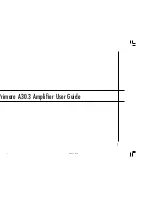
Fredenstein HD Reference Preamplifier
when possible. The most common use for high pass filters is to reduce unwanted rumble from air
conditioners or from outside sounds when acoustic isolation tends to be be less than perfect.
High pass filters can also help reduce leakage from other sources when the the instrument has
minimal low frequency information, and the leakage mostly exists as low frequencies. Sometimes,
we use high pass filters to sculpt the sound and clear some space for other instruments, but this
technique is probably better done in the mix and better done with flexible or specifically chosen
filters. It is just safer, because once one filters out the lows, they are gone permanently. The
microphone's high pass filter and most mic-pre's high pass filter, were probably never intended to be
an artistic EQ, but were intended to be simple problem solvers.
We might characterize the high pass filters in the HD Reference as relatively gentle and safe. The
filters are 6 dB/oct types with minimal phase shift and low group delay distortion. Steep filters tend
to introduce more phase shift which basically means the low frequencies may arrive milliseconds
later than mid frequencies. This can be less than ideal with percussive instruments like drums unless
the object was to lessen the impact and realism. But steep low pass filters can be more effective at
removing garbage below a certain frequency. For the HD Reference, the filters were chosen with
the idea that users would use a pre-amp of this quality to record in better spaces and that the HD
Reference would be a natural choice for percussion instruments like drums and piano. In fact, with
the right mic, it may well be the first choice with any acoustic instrument that is intended to invoke
realism or sound natural.
Fredenstein HD Reference Manual V1.0 Feb 5, 2016 Page 4
Содержание HD Reference
Страница 1: ...HD REFERENCE Operating Manual...































